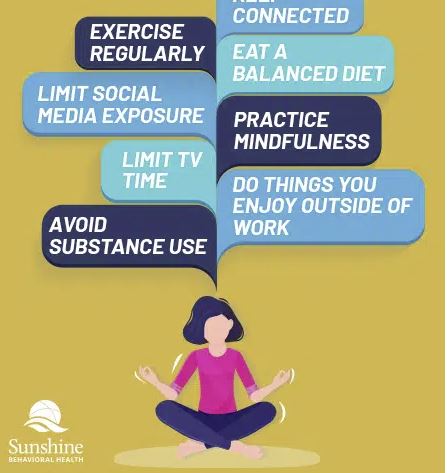
MENTAL HEALTH - People are returning to the workplace and classroom (or are planning to) as COVID-19 restrictions are eased. For some, anticipating a return to normal has become a source of stress, but understanding signs of stress can help people manage the condition and such transitions.
Returning to “Normal” Guide Mental Health, Post-COVID
A lot has changed since the World Health Organization declared the outbreak of the novel coronavirus-caused COVID-19 a global pandemic on March 11, 2020. Since then COVID-19 has killed millions and sickened hundreds of millions around the world.
Lockdowns and safety measures have kept many of us out of the workplace or classroom for months or longer. That’s affected our mental health. For some, the isolation has fueled anxiety and depression. For others, the prospect of returning to the workplace is a major source of stress.
Americans started receiving COVID-19 vaccines in December 2020, with the most shots being administered in April 2021. As variants of the coronavirus have been emerging, hundreds of millions of vaccines have been administered throughout the United States and around the world.
Since the vaccines have appeared to reduce cases and deaths, life has in some respects and in some places has begun to return to normal.
Except where it hasn’t.
Mental Health
The pandemic has not only affected our physical health but our mental health, too. Throughout COVID-19 people struggled (and continue to struggle) with uncertainty, isolation, and grief.
One survey looked at the mental health of full-time American workers in the first months of the pandemic. Among its findings: the pandemic was not good for mental well-being. Before COVID-19, 39 percent of workers reported mental health issues. After the coronavirus hit, that number climbed to 46 percent.
More than half (55 percent) of respondents said since the pandemic started, their mental health problems have interfered with their work.
Mental health issues can lead to other problems, including co-occurring disorders, such as when mental illness and addiction coexist. Left untreated, such disorders can result in many long-term health problems, risky behaviors, and reduced work quality.
Struggling Day to Day
Addiction and substance use problems did not dwindle, either.
Drug overdose deaths were on the rise even in 2019, but they climbed considerably in 2020, particularly during the early months of the pandemic, according to the Centers for Disease Control and Prevention (CDC). Fear and despair may be factors, but since many treatments and support options were closed, limited, or moved online, that led some to relapse.
Nationwide alcohol sales also accelerated, by 54 percent in the early weeks of lockdowns. Alcohol consumption went up, too, by 14 percent from 2019 to 2020. The frequency of use also rose. Other findings include:
One in 10 missed work or were less productive due to addiction or substance abuse.
36% of those struggling with substance abuse said it’s hurt their work even more since COVID-19.
One-third said that a significant portion of their workday suffers when they also are grappling with mental health or substance abuse problems.
Working from home is leading to other issues as well. Not everyone’s work-from-home stations are ergonomically sound. That can contribute to neck, shoulder, and back pain, leading to reduced efficiency, increases in sick days, worsening mood disorders, and dependence on pain medications.
For anyone struggling with mental health issues, be it anxiety, depression, or thoughts of self-harm, there are many ways a person can find help.
Calling a health care provider can be one way. So can reaching out to your primary care physician. If those aren’t options, below is a sampling of resources for finding help:
- National Suicide Prevention Lifeline, 800a273aTALK (8255). This is a national network of centers that offer free and confidential support 24 hours a day to anyone struggling with a mental health crisis. There are chat options too.
- Centers for Disease Control and Prevention (CDC). The CDC has resources for employees, how they can better manage job strain during the pandemic. It offers a list of symptoms, work-related factors that can add stress, tips to build resilience and handle stress, and ways to find help. It also has information for the workplace, including general, industry-specific, and health department resources.
- LinkedIn Learning has courses, too, including Supporting Your Mental Health While Working from Home. There is a fee, but this resource offers advice on challenges such as managing disruptions and balancing work, parenting, and school.
- National Alliance on Mental Illness (NAMI). This grassroots mental health organization is dedicated to helping people through mental illness. It has links to local (state) chapters, news, a blog, a guide, and resources for COVID-19. Its national helpline, 800a950aNAMI (6264), is open to anyone needing support or advice.
- National Domestic Violence Hotline. 800a799aSAFE (7233), or text START to 88788. Help is available 24 hours a day, for survivors and victims of domestic abuse. Expert advocates are on the line to offer free, confidential support, information, and referral services.
- Resuming Business Toolkit. The CDC also has a toolkit for employers to help them slow the spread of COVID-19 as they reintroduce workers to the workplace. It includes checklists, protection advice, resources, and more.
- Substance Abuse and Mental Health Services Administration (SAMHSA). This federal clearinghouse of information has a Behavioral Health Treatment Services Locator that lets users search for mental health and substance abuse treatment options by location, specialty, insurance plan, and more.
- U.S. Department of Labor. This federal site has links to finding vaccines and help for those suffering long-term COVID-19. There is also information about workplace safety, wage and hour laws, and unemployment insurance.
Some employers have Employee Assistance Programs (EAP), too, which offer things such as free assessments, short-term counseling, referrals, and more for workers struggling with personal or work-linked problems. Human resources departments often have information on EAPs.
ABC Comment have your say below:

Leave a comment
Make sure you enter all the required information, indicated by an asterisk (*). HTML code is not allowed.
Join
FREE
Here











